This is the Contarex, a professional grade 35mm SLR camera produced by Zeiss-Ikon starting in 1960. This first generation Contarex earned the nickname “Bullseye” for the large prominent circular exposure meter above the lens. The Contarex was one of the first West German SLRs with a focal plane shutter, and was built to withstand harsh environments, even outer space. It’s high build quality had a critical side effect which was it was incredibly difficult to repair if something ever went wrong. Many camera shops back in the 1960s would refuse to touch them, and today there is hardly anyone left in the world who can repair them. The Contarex was as heavy as it was beautiful, and is extremely collectible today.
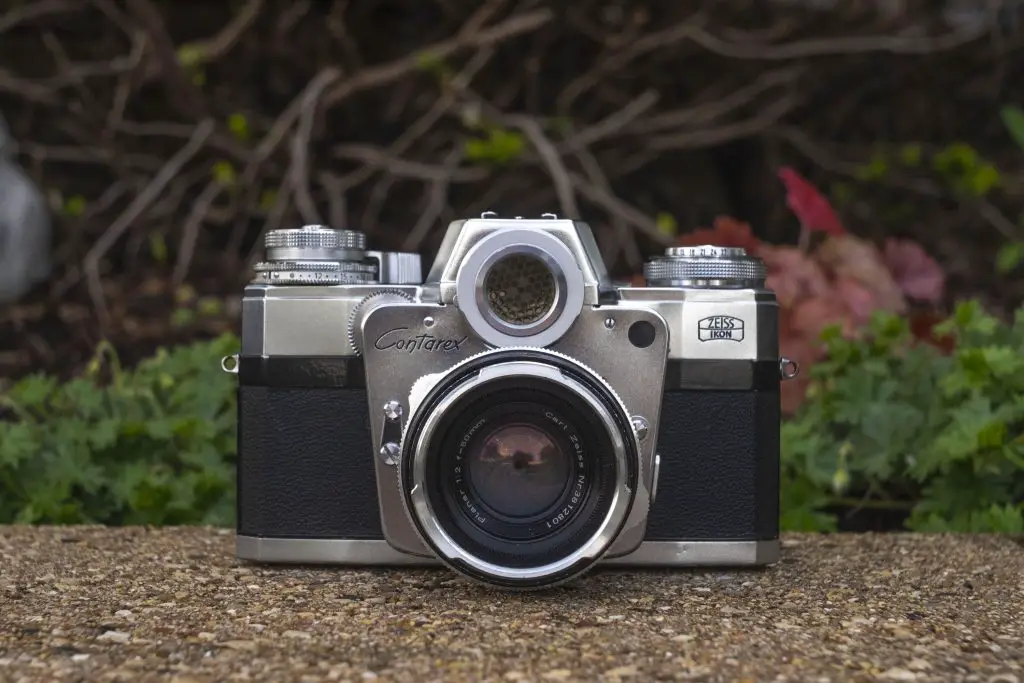 Film Type: 135 (35mm)
Film Type: 135 (35mm)
Lens: 50mm f/2 Carl Zeiss Planar coated 6-elements
Lens Mount: Contarex Bayonet
Focus: 12 inches to Infinity
Viewfinder: Fixed SLR Pentaprism
Shutter: Cloth Focal Plane
Speeds: B, 1 – 1/1000 seconds
Exposure Meter: Coupled Selenium Cell w/ top plate and viewfinder match needle readout
Battery: None
Flash Mount: Coldshoe and M and FP Flash Sync, X sync at 1/60
Weight: 1160 grams (w/ lens), 926 grams (body only)
Manual: https://www.cameramanuals.org/zeiss_ikon/zeiss_ikon_contarex.pdf
Manual (in French): https://www.cameramanuals.org/zeiss_ikon/zeiss_ikon_contarex-french.pdf
Brochure: https://www.cameramanuals.org/zeiss_ikon/zeiss_ikon_contarex_booklet.pdf
How these ratings work |
The Contarex Bullseye is a lot of things. It is one of the most desirable cameras by collectors, one of the most expensive, one of the most complex in design and use, and to some, one of the most beautiful cameras. But one thing you can’t say is that it’s one of the most fun to use, because it’s not. The camera’s excessive weight and complexity are always on display. Using an expensive camera with such a reputation for reliability issues and that if it breaks, I’ll likely never get it fixed again made me terrified to use it. I got great images from it, but I think the best place for it today, is on a shelf, out of regular use. | ||||||
| Images | Handling | Features | Viewfinder | Feel & Beauty | History | Age | |
| 2 | 1 | 2 | 1 | 2 | 1 | 20% | |
| Bonus | none | ||||||
| Final Score | 10.8 | ||||||
History

In the years following World War II, Zeiss-Ikon would revise their pre-war Contax rangefinder and make it the professional camera of choice to compete with the Leitz Leica. In 1954 when the Leica M3 made it’s debut, it blew away the competition to the point where if you wanted to compete with the high end of the 35mm market, you’d have to come up with something completely new.
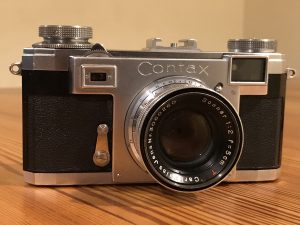
While the Contax was still popular, Zeiss-Ikon knew that the future of photography lied in the Single Lens Reflex camera, and in 1954 began work on an all new SLR to replace the Contax IIa and IIIa, which they hoped would appeal to professional photographers.
The post war years were difficult for Zeiss-Ikon in West Germany. Although their primary factory in Stuttgart was largely spared from destruction in the war, it had never made a 35mm camera and did not have the tooling, nor the experienced workforce to do it. Things were a little easier in East Germany where Zeiss-Ikon was able to capitalize on the success of the Dresden area camera companies. The Contax S was a semi-professional SLR that first went into production in 1948 which allowed them to build up a supply of German made SLRs.
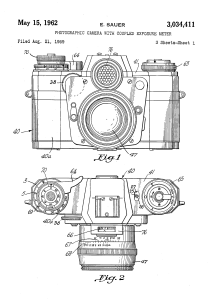
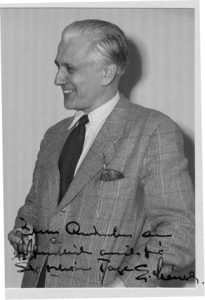
Zeiss-Ikon Stuttgart on the other hand, took their time in building up their capacity, insisting that everything be built to the highest quality standards. One of Zeiss-Ikon’s biggest post-war losses was the departure of their skilled designer, Hubert Nerwin who went to America to work for Graflex. His replacement was an assistant that worked under him named Edgar Sauer. It was Sauer who was tasked with creating an all new professional grade SLR for Zeiss-Ikon.
First put in charge of photographic lenses, Sauer would design the leaf shutter Contaflex SLR that first went on sale in 1953. After completing the Contaflex, in 1954, work began on a prototype using the names Contax IV and Contaflex, which would eventually become the Contarex.
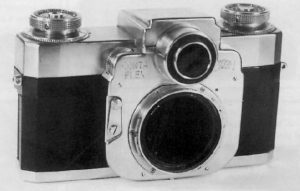
From it’s earliest days, the feature set of the Contarex was set to include an instant return mirror, full open aperture focusing, a body controlled iris mechanism, a new bayonet lens mount, eye level pentaprism, and a built in exposure meter. For cameras released in the 1960s, this would have been a rather standard set of features, but at the time the Contarex first went into development, this was a massive undertaking. So massive, that it regularly caused delays in design and manufacturing as Zeiss-Ikon often had to literally invent new ways to accomplish tasks that had never been done before.
In addition to the complexities of building the camera, Zeiss-Ikon’s stringent specifications for the camera’s lenses also posed problems as all existing lens formulas needed to be revised in order to both meet their standards, but also to work within the Contarex’s SLR design.
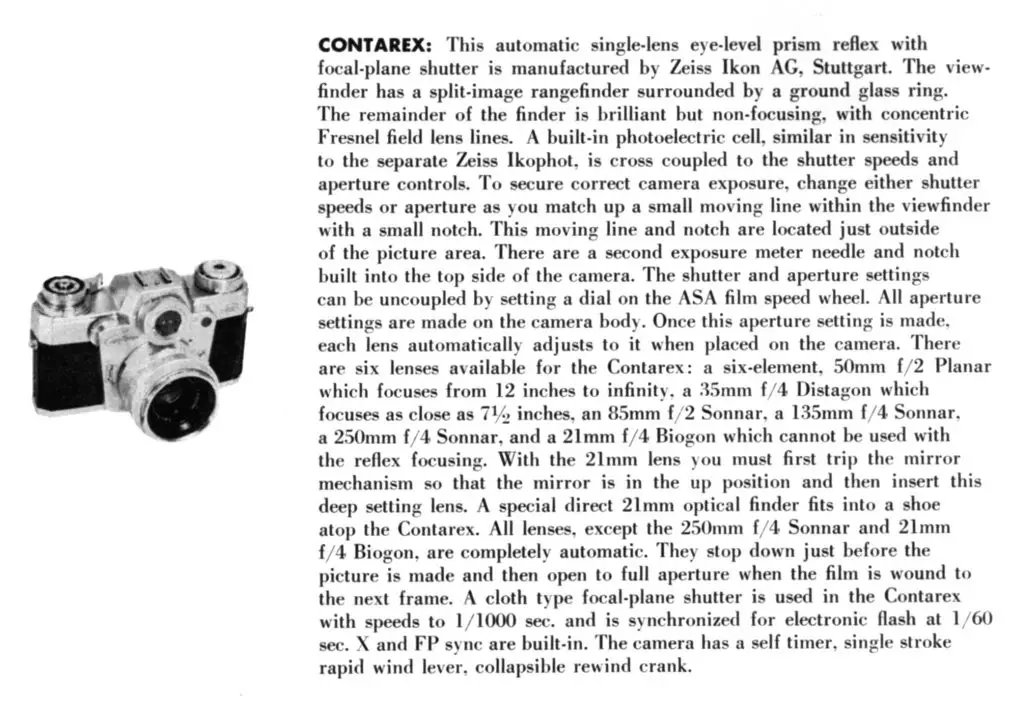
First announced at Photokina 1958 in Cologne, Germany, the Contarex generated excitement for it’s gorgeous design and aspirational features. In addition to the standard 50mm f/2 Planar lens, five additional lenses were announced from a 21mm f/4 Biogon to the 250mm f/4 Sonnar. All of the Contarex lenses used an extremely smooth double-helix for extremely precise and tight focus.
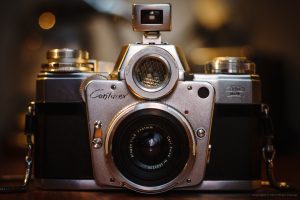
The 8-element 21mm Biogon would not work with the camera’s reflex viewfinder as it required the mirror to remain in the up position while it was mounted. For composition, an auxiliary 21mm viewfinder would attach to the camera’s accessory shoe. The loss of the reflex viewfinder was not an issue as the Biogon had an extremely wide depth of field. At f/4.5, everything from about 3.5 feet to infinity is in focus, so everything except closeups could be guesstimated. Stop the lens down and the Contarex becomes the world’s most expensive focus-free camera!
Link: For some excellent beauty pics of the Biogon lens, viewfinder, and sample images of it adapted digitally, see briantho’s Flickr gallery.
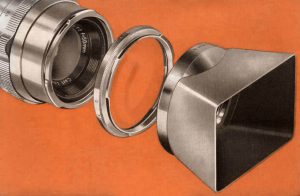
Being a professional camera, the Contarex had a wide selection of accessories available, from bellows to microscope attachments. Zeiss-Ikon was clearly a fan of bayonets as the front of most Contarex lenses from the 21mm Biogon to the 135mm Sonnar used the same bayonet mount which accepts all of the same filters and lens hoods available, allowing for quick attachment of many different combinations of lens accessories. If you wanted to switch from wide angle to telephoto while still using the same Contapol polarizing filter and hood, you were just a couple twists of the wrist away!

The camera received widespread acclaim, but continued delays pushed dealer availability another year, as the camera wouldn’t show up in dealer catalogs until September 1959, with first shipments not occurring until early 1960.
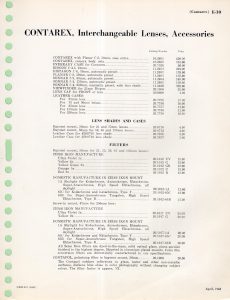
In order to achieve the camera’s long list of features and extreme standards of quality, every one of the nearly 1100 parts were hand machined and pieced together which not only increased it’s cost, but also it’s weight. With a body only weight of 926 grams, and with the 50mm Planar, it topped the scales at 1160 grams which was incredibly heavy for an SLR camera of the time.
It’s cost was even more of a shock as it had a list price in Germany of 1450 Deutsche Marks or in the US $450 (later $500) with the 50mm Planar lens, which when adjusted for inflation, compares to over $3900 today.
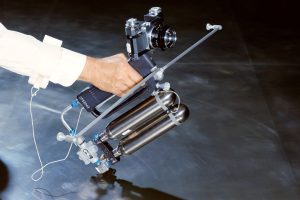
Zeiss-Ikon aimed for the stars and both literally and figuratively hit their target as a Contarex was used by astronaut Ed White on the first American Space Walk on June 3, 1965. In order to be used with a bulky space suit, the viewfinder was removed and both the film advance and shutter release buttons were enlargened. The shutter speed and aperture were fixed at 1/500 and f/11 to allow for the greatest chances of proper exposure in space. In total, White managed to capture 12 images with the camera, which was quite an accomplishment considering his restricted movement.
The exact camera used by White is currently on display at the Smithsonian National Air and Space Museum in Washington DC. For more information on Ed White’s Contarex camera, check out this excellent article by Cheyenne Morrison at Casual Photophile.
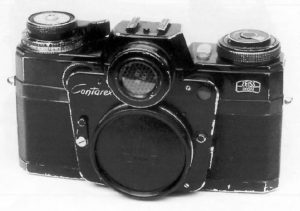
The Contarex Bullseye was only produced with a satin chrome finish, but according to the Fall 2002 issue of Zeiss Historica, black painted versions could be specially ordered through the factory with a 185 DM premium. Most black paint Conarexes were regular chrome plated versions, but painted in a special non-reflecting black lacquer. This black paint upgrade could be done on previously purchased cameras and lenses by sending them back to the factory in Stuttgart. A very small number of black paint cameras were painted before the chrome plating, but these are exceedingly rare. As with any rare item, some cameras have been painted black in the years since by owners, but these do not exhibit the same level of quality as original Zeiss painted ones and should be avoided.
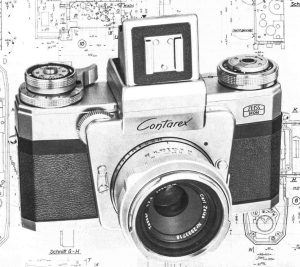
In addition to the original Contarex “Bullseye”, a revised model called the Contarex Special was released which omitted the exposure meter, but replaced the fixed pentaprism with an interchangeable one that could be used at waist level or with a special microscope adapter. This camera is extremely rare as only an estimated 1600 were ever produced.
The original Contarex Bullseye was produced until 1963 and was replaced by a revised Bullseye “D” which stayed in production until 1967. The Model D improved the meter diffuser adding a locking tab for taking it off, adding support for interchangeable focus screens, expanding the DIN film speed range, and added the ability to insert a 6mm data strip inside the camera for the purposes of recording written data directly onto the film.
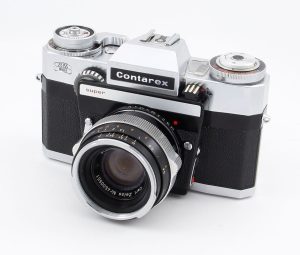
In 1966 and 67 two cosmetically enhanced models called the Contarex Professional and Super made their debut, the later of which offered TTL metering and a full information viewfinder.
The Contarex series was produced until 1975, and in total 25 different lenses, including two zooms and a 400mm monocular, were developed using the Contarex mount. Despite sluggish sales, Zeiss-Ikon continued to innovate, making Contarex lenses the best they knew how.
According to a 1978 issue of Modern Photography, in his “Camera Collector” article, Jason Schneider states that a total of about 55,000 Contarexes were made, with 32,000 of those being the first design which I assume means the Bullseye.
Considering the extreme complexity and high price of the Contarex, I’m actually surprised the numbers are as high as that, but regardless of the number, today, the Contarex is a very expensive and very desirable camera. In that 1978 article, Schneider states that the camera was already starting to become collector’s items, so in the 40 years since, prices have continued to climb.
Repairs
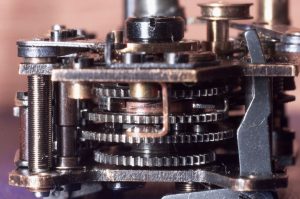
The Zeiss-Ikon Contarex is perhaps one of the most difficult cameras to repair of any ever made, by any manufacturer. The camera is made up of over 1100 parts, of which 43 need to be removed just to remove the camera’s top plate.
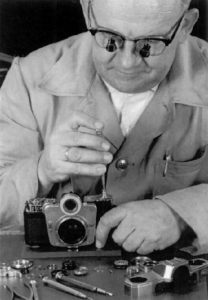
Normally I reserve the Repairs section in my reviews for repairs I’ve done myself, but for the Contarex I’ll tell you that to the best of my knowledge, there is only one person in the world who is capable of giving the camera a proper overhaul. There might be others who claim to be able to do it, but I would definitely do my homework first as only the most dedicated and experienced person should touch one of these cameras.
If however, you are interested in getting your Contarex repaired, you’ll want to get in touch with Henry Scherer at zeisscamera.com. As I write this review, Henry charges $1250 for a complete overhaul of the Contarex Bullseye, and $1850 for the Contarex Super or Professional.
Assuming you’re not in the market to spend over a thousand dollars to get your camera repaired, I still recommend checking out Henry’s website as he has a wealth of information about the Contarex talking about it’s complexities and even offers a few tips for how you can test the camera yourself. His site is fascinating and well worth your time.
Update: Shortly after posting this article, I was contacted by Igor Silva from Oficina Analógica who has experience repairing the Contarex. He is located in the EU and has several images of a Contarex being repaired on his page that are worth checking out. If you are interested in contacting Igor to discuss your Contarex, contact him through his Facebook page.
My Thoughts

The Contarex Bullseye is expensive. This is a camera that I likely would have never attempted to acquire on my own. In addition to it’s price, I don’t seek out cameras just to put them on a shelf, I want to shoot them, but when someone offers to loan one to me, all bets are off. That was the case of a reader to this site who also sent me the Voigtländer Ultramatic CS which I’ve previously reviewed.
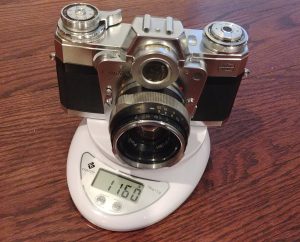
Upon first taking the Contarex out of the box, it’s impossible not to notice the weight. At 1160 grams with the lens attached, this is the heaviest 35mm camera I’ve ever handled. I have many medium format TLRs that weigh less than this. After reading more about the camera and knowing the extreme complexity of the camera’s innards, it still feels heavy, even when you are prepared for it.
But with heft, comes a reassuring sense of density. This camera is sold. There does not appear to be any plastic used anywhere in the construction of the camera or lens. It’s all just glass, metal, and in the case of the body covering, some kind of synthetic leather.
I did not realize it until after I had started writing this review, but this particular camera is the later “Model D” from 1963 that added a locking switch for the exposure meter diffuser and added a small slit on the back of the camera for inserting something into the film compartment to put notes in between exposures on the film. I did not know about this feature while shooting the camera and wished I had a way to test it.
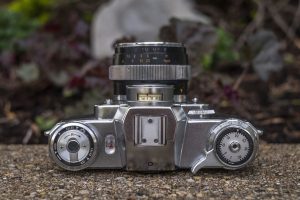
The top plate of the Contarex is attractive and has a lot of symmetry going on. On the left is a film reminder dial and pop up rewind lever. The center of the dial has a small circle of body covering which is a nice touch. To it’s right is the read out for the exposure meter with red arrows pointing towards the center for over and under exposure. This readout is duplicated in the viewfinder, but without the red arrows.
On top of the pentaprism is the accessory shoe with focal plane indicator behind it. On the right side is the combined shutter speed selector, DIN film speed selector, film advance lever, exposure counter, and threaded shutter release button. The exposure counter is subtractive and counts down to 0 to show how many exposures are left.
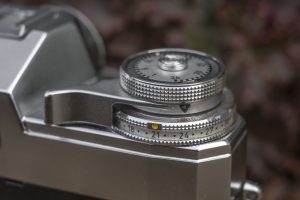
Changing shutter speeds requires rotating the knurled ring below the advance lever and exposure counter to your chosen shutter speed. There is a black arrow with a small finger that is on the side of the advance lever that can be seen from the back of the camera or top down. Shutter speeds may be selected with either the shutter cocked or not.
Beneath the shutter speeds is a second ring for setting the proper film speed using only DIN speeds 10 through 33 (ASA 8 through 1600). Setting the film speed requires lifting the top half of the shutter speed ring and rotating it so that another black arrow (not shown in the image to the right) on the top knurled ring points to your desired film speeds. Next to the black arrow are 2x and 4x filter compensation settings which should be used to double or quadruple the meter rearing. A green dot (also not shown in the image) is also on the DIN scale and should only be used for Bulb exposures as it overrides the film speed to shutter speed coupling. The yellow arrow pointing to DIN 21 in the image to the left is explained later in this article.
Caution: If this whole shutter and film speed business sounds complicated, trust me, it confused the hell out of me even holding the camera in my hands. I wish I could tell you that it will make sense if you ever get a chance to use a Contarex yourself, but that simply is not true.
The Contarex manual says there are shutter speed locks that change depending on which film speed is set limiting the number of available shutter speeds. The manual says that if DIN 27 (ASA 400) speed is set, the slowest shutter speed you can choose is 1/30. You can use slower speeds, but only when selecting slower film speeds. While testing the camera, I felt these locks preventing me from choosing certain speeds, and without having a complete understanding of how they worked, I stopped messing with it.
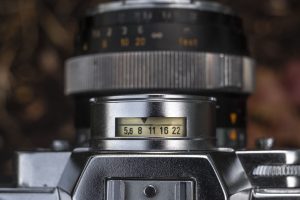
Visible directly above the meter, and in front of the accessory shoe is the aperture readout. This is perhaps one of the most distinct, and also confusing parts of the camera. What’s so scary about some f/stops you might ask?
In an effort to make the Contarex as advanced as possible, Zeiss-Ikon built in what they call “Automatic Exposure Control”. Now, this isn’t Automatic Exposure like you think in which the camera uses a meter reading to automatically choose an f/stop or shutter speed, rather, it uses a complicated series of couplings to take a reading from the large circular meter (where the camera gets it’s “Bullseye” moniker) and couples them to your chosen readings.
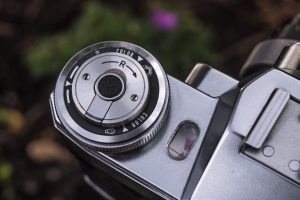
The meter readout on the top plate and inside the viewfinder is a simple match needle, in which the idea is to get the needle pointing to the center of the scale where proper exposure is obtained. This works like hundreds of other match needle SLRs, but how it’s accomplished is gloriously German in complexity.
The meter is coupled to both the aperture ring, which is that circular wheel to the right of the scale (when looking down at the camera), and the shutter speed selector I previously discussed. But unlike most other SLRs in which f/stops are controlled on the lens, everything is controlled on the camera’s body. This adds complexity to the lens mount of the camera because the iris in the lens must take it’s setting from the camera itself. On the plus side however, this meant that the exposure coupling was compatible with every single lens developed for the Contarex, something that other exposure coupled SLRs can’t claim.
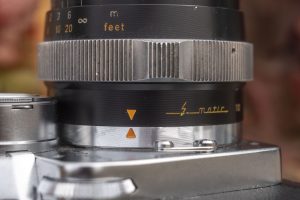
In order for this complex exposure coupling to work, a ring around the lens must be set to where two yellow arrows are pointing at each other like in the image to the right. Turning this ring away from the two yellow arrows is used for flash use which I did not use, nor completely understand. On my example, enabling flash mode disabled my ability to stop down the lens. I am not sure if there is a defect in this particular camera, or if I just didn’t understand the feature. Considering the complexity of the Contarex, I’ll assume the latter is true. Reading the manual was of no help either, but to be honest, I didn’t spend much time with it as I had no interest in using a flash.
Getting back to the aperture scale, I quite liked the location of the aperture control wheel as it was comfortably located by my right index finger while keeping the camera to my eye. With a shutter speed appropriate for outdoor photography, I was able to choose an f/stop that resulted in proper exposure easily. Whether this was an intentional homage to the similar wheel on the Contax rangefinder or simply a necessity of the design is anyone’s guess, but it’s implementation is much nicer on the Contarex than any Zeiss (or Nikon) rangefinder that I’ve used. Something notable about this wheel is that it is infinitely variable, so apertures of anywhere between the displayed numbers are possible.
For normal daylight use, the exposure meter has a honeycomb shaped baffle over the selenium meter. If a reading in low light or when shooting indoors is desired, you can remove this baffle and expose the selenium cell directly, which increases sensitivity by four stops, or 16x. The baffle is mounted to the camera using a bayonet mount whcih on the original Contarex simply twists off. With the baffle removed, the ASA/DIN film speed must be set to a yellow dot which you can see earlier in this review.
Edit 8/23/2021: Site reader Terry Byford pointed out to me that the main purpose of removing the baffle over the meter is to be used for incident light measurements. While the extra 4 stops of light is useful in low light too, this is the circumstance where most people would want to remove the baffle.
On the Model D seen here, there is a tiny little lock that must be pressed before you can remove the baffle. In the image to the left, you can see the lock directly above the ‘x’ in ‘Contarex’.
Light entering the selenium meter is controlled by a 10 blade iris, which should put to rest any doubt about the complexity of this camera. Think about it, an iris, just for the meter! Oh, and that dark circle opposite of the Contarex logo is a light window for illuminating the match needle read out. Be sure not to block this window or else you won’t be able to see it.
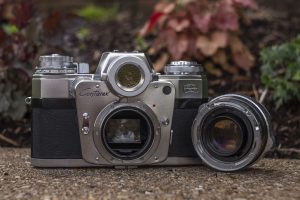
The Contarex uses a proprietary bayonet lens mount that is overly complex, but thankfully is easy and extremely smooth in operation. A release button just above the 3 o’clock position around the lens mount must be pressed while rotating the lens counter clockwise. When a red dot on the lens lines up with the red dot on the body near the 2 o’clock position lines up, the lens may be pulled away from the camera. The lens mount has a spring for keeping tension on the lens when mounted, so reinstalling the lens requires a small amount of inward pressure while aligning the dots, before you can lock it back into position by turning it clockwise.
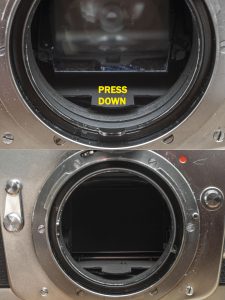
When using the 21mm Biogon wide angle lens, the reflex mirror must manually be set in the up position, as the design of the rear lens element will obstruct the mirror. In order to manually lift the mirror, first remove the lens and operate the film advance lever, then use your index finger to press down on the curved metal tongue at the base of the mirror box, near the 6 o’clock position which will cause the mirror to flip up and stay there. With the mirror up, you may then proceed to mount the 21mm lens. After removing the Biogon lens to use any other lens, the mirror will automatically reset itself the next time the film advance lever is operated. This whole operation can be done without wasting any film as the shutter will not fire when raising or lowering the mirror.
To the left of the lens mount is the self timer lever. Turning this lever counterclockwise as far as it will go, results in an approximate 12 second delay when releasing the shutter. A shorter delay may be set by turning the self-timer lever part way. According to the manual, intermediate settings for a shorter delay can be set at clicks felt while setting this lever. The manual also suggests that setting the self-timer should only be done after operating the film advance lever. In my experience with old cameras, I generally do not play with the self-timer, which I think is very good advice for any Contarex user today.

The symmetry on top of the camera is extended to the bottom where a centrally located 1/4″ tripod socket is located on a small foot which helps balance the camera when set on a flat surface with a lens attached. On either side of the bottom plate are film locks identical to those used on the Contax rangefinder. This allows for cassette to cassette film transport using appropriate reloadable cassettes.
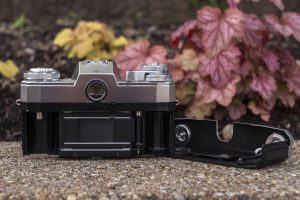
With the two release locks in the “R” position, the entire bottom and back comes off, revealing the film compartment. Film transport is from left to right onto a removable take up spool. When loading in a new roll of film, remember to set the exposure counter to the total number of exposures left.
Available for the Contarex were interchangeable magazine backs that had a sliding dark slide that would protect the film when removing it from the camera. With multiple magazine backs, a photographer would be able to quickly switch between different film emulsions, mid roll, without having to rewind the film back into it’s cassette. When using the magazine back, cassette to cassette transport was not compatible as the take up spool is permanently mounted in the magazine.
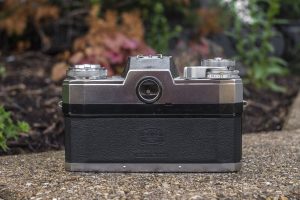
When looking at the back of the camera, there is an embossed “Zeiss-Ikon” logo in the rear body covering, immediately below the opening for the viewfinder. At first glance, that’s all there is, but upon further inspection, there is a small opening along the edge of the chrome top plate and black trim, just to the right of the viewfinder.
This opening only exists on the Contarex Model D released in 1963. The purpose of this little opening is for inserting special 6mm wide “note strips” into the film compartment, which exposes writing onto the film as each image is captured.
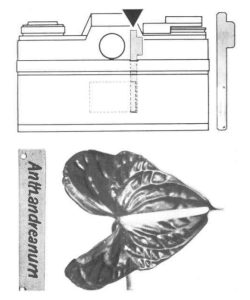
This is a feature that I didn’t even realize the camera had until after shooting it and starting on this review. I found very little information on this feature online as I doubt many people used it. It appears to require special strips designed for the Contarex that may or may not have been reusable. Aside from one small reference in a Contarex pamphlet seen to the right, I’ve found no other information on how this feature worked. If you look at the image above of the opened film compartment, you can see a little notch that redirects the strip down, across the film plane.

The viewfinder in the Contarex has a highly accurate split image rangefinder in the center which allows you to align vertical lines seen through the two half images. A “micro-raster” ring surrounds the rangefinder patch for precise focus on things without a vertical line. The 50mm f/2 Planar lens reviewed for this article could be focused down to 12 inches which is closer than most “non-macro” lenses. For even closer focus without the use of macro rings or a bellows attachment, the 35mm f/4 Distagon focuses down to 8 inches.
The Contarex viewfinder is unusually bright for an SLR designed in the late 1950s, owing to the circular Fresnel pattern that makes up the rest of the focusing screen. A side effect of this bright Fresnel screen is that everything outside of the central rangefinder patch and “micro-raster” ring, cannot be used for focusing. This was a compromise that Zeiss-Ikon employed on the Contaflex SLR as well. With the Contarex Model D, the viewing screen can be changed to one with a ground glass that can be used for precise focusing across the entire image, but at the loss of brightness.
Although the Contarex is equipped with an instant return mirror, it does not have an instant open iris, which means that after firing the shutter, the lens iris remains at whatever f/stop is selected, darkening the rangefinder and the rest of the viewfinder until the next time you operate the film advance lever.
Still with me? I probably don’t need to say this, but the Contarex is a very complex camera. Edgar Sauer and the other men and women at Zeiss that worked on it’s design clearly spent a lot of time making the best and most feature rich camera the could. In many ways, they succeeded, as the camera was very well built and offered features that not many other cameras at the time had. But what was it like to use it?
My Results
The Contarex is a mighty camera, both figuratively and literally. The thing is a beast. Its complicated, it’s heavy, and it’s valuable. It took me a while before I found the ‘cajones’ to take it out. For it’s first roll, I shot some bulk Kodak Tri-X 400 that had expired in the 1990s. I’ve shot this film before and know it shoots at box speed, so I set the meter to 400 and let the camera make it’s recommendations.
Not wanting to only experience the Contarex in black and white, later in the summer I loaded up a roll of fresh Fuji 400. I didn’t make a conscious decision to only shoot 400 speed film in this camera, that’s just how things worked out.
There was never any doubt about the quality of images I’d get from the Contarex. I only had access to the 50mm Planar, but that’s hardly a bad thing. Sharpness was great corner to corner, color accuracy on the rather ordinary Fuji 400 film was superb, and there were no obvious optical anomalies like aberrations, coma, or vignetting. The images pop out and have an almost digital look to them. I didn’t love my black and white images shot on the Tri-X as much, but that’s entirely a result of my compositions and not the camera.
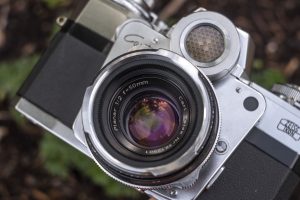
The Contarex camera is very desirable by collectors, but it’s lenses are also popular choices for adapting to digital. While I didn’t have a Contarex adapter to try it out myself, I found this gallery of digital images shot using the 50mm Planar on a Sony a7 mirrorless. Check out the images for yourself as they are quite nice.
Setting aside the discussion of nearly perfect images that it is capable of, more can be said about the use of this camera. Quite simply, I did not enjoy it.
Using the Contarex is a case where the more you know about it before picking it up, the more fearful of it you become. I wonder what my impressions would have been had this been my first exposure to a classic manual focus film camera. If I had the benefit of ignorance to it’s complexity and value, I think I might have had a greater chance at dismissing it’s eccentricities as “that’s just how things used to be”. If I wasn’t aware that this camera is extremely expensive and almost impossible to repair, I might have been more casual in it’s use, trying shots where I didn’t need to tiptoe around for fear of damaging it.

I did like the ease in which I could change f/stops using my right index finger. This is a better design than the wheel on the Contax rangefinder and other cameras inspired by it. Changing focus on the Planar lens was liquid smooth with just the right amount of resistance that was neither too tight nor too loose. I do not know the history of this particular camera to know if it’s been serviced before, but if it has not, color me extremely impressed that the camera has survived this long in this great of condition.
I both liked and didn’t like the viewfinder. As a vision impaired person, I often love large and bright viewfinders like the one in the Contarex, but it’s implementation of the non focusing Fresnel pattern renders most of the viewfinder useless for focusing. Yeah, the rangefinder circle was very large and easy to use, but losing full focus ability takes some getting used to.
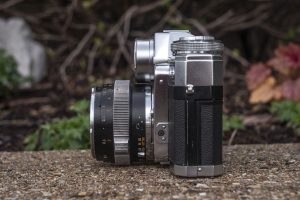
It should be no surprise that with the extremely complex design of the camera, that the shutter release is quite noisy. A cacophony of sounds is produced by the instant return mirror moving up and down, a series of levers and linkages from the coupled aperture system that stops down the iris, and the normal sounds from the focal plane shutter. Strangely, there is some type of gear train that sounds like the slow speed governor on a leaf shutter each time you fire the shutter, even at the fast speeds. This is definitely not a camera you’d want with you in situations where you need to be discreet.
In this article, I’ve well established that the Contarex was a heavy and expensive camera, but those two factors alone weren’t it’s ultimate downfall. Had this camera made it’s debut a couple years earlier, it likely would have gained a strong foothold in the professional market as even by the mid 50s, the need for a professional level SLR was already evident.
Sure, the Ihagee Exakta and KW Praktina already existed and to some degree, filled a niche for the pros, but the user-unfriendliness of the Exakta and the East German reputation of the Praktina limited their appeal.
But the Conatrex wasn’t released in the mid 1950s, it wasn’t announced until late 1958, and didn’t even make it into photographer’s hands until early 1960 after another certain camera had already made it’s debut. What camera was that?! Repeat after me….
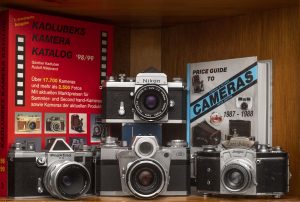
Ni – kon.
Yep, the Nikon F didn’t just turn the professional camera industry upside down, it was also the harbinger of death to pretty much every other professional 35mm SLR system. Despite it’s extremely high quality, innovative features, and world class optics, the Contarex was already out of date upon it’s release. Simply, the Nikon F did everything the Contarex did, but better, and easier, and cheaper.
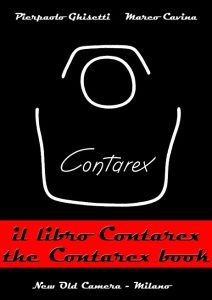
Is the Contarex a bad camera? Of course not. Zeiss-Ikon, like most German camera companies only ever made cameras to the highest degree of quality, performance, and complexity, and the Contarex is no different. This is an extremely attractive camera with symmetrical styling, tons of features, and one of the most respected lens lineups made for any camera, ever. If you are lucky enough to find one in good condition at a price you can afford, it is absolutely worthy of being in your collection…on a shelf. If you want to use the lenses, adapt them to digital. From a photographer’s standpoint though, there’s better options out there.
If you’d like to know more about the Zeiss-Ikon Contarex, authors Pierpaolo Ghisetti and Marco Cavina put together an extremely elaborate book on the Contaflex simply called “The Contarex Book”. The book is written in both Italian and English and is said to be extremely detailed and includes many excellent drawings and photographs of the Contarex and it’s system. I did not actually have access to the book for this review, but will definitely be on the lookout for it. Check it out!
Related Posts You Might Enjoy
External Links
http://camera-wiki.org/wiki/Contarex_I
https://www.japancamerahunter.com/2019/03/camera-geekery-zeiss-ikon-contarex-bullseye/
http://elekm.net/pages/cameras/contarex.htm
https://www.photo.net/discuss/threads/contarex-bullseye.505878/
https://filmphotographyproject.com/content/reviews/2018/12/zeiss-contarex-super-35mm-camera/
http://www.zeisscamera.com/services_overhaul-contarex.shtml
https://basepath.com/Photography/Contarex.php (archived)
https://www.edoardomelchiori.com/en/zeiss-ikon-contarex-bullseye


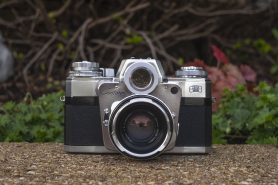
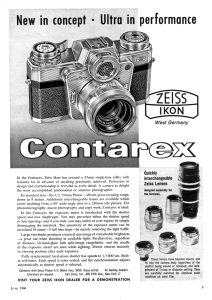
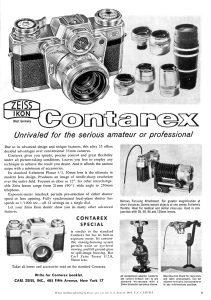
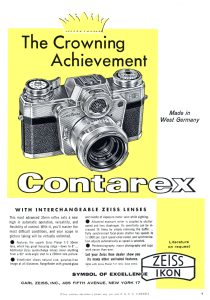

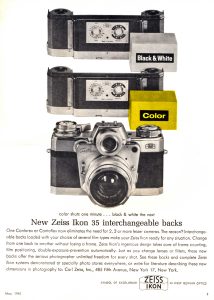
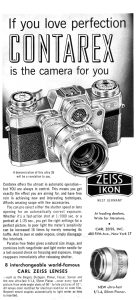
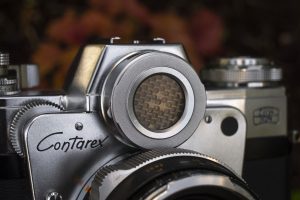



























I learned a lot here, thanks. When considering the complexity of some of these early German SLRs,questions of culture and economics come into play. Do these engineers ever make allowances for ease of use? It seems to me that a no-compromise attitude to having all the features available overrides concerns for practical use, and never-mind how to keep repairs economical. The 1959 Nikon must have been a hard lesson for them.
Hmmmm … is this the $3000 Autographic? Zeiss certainly preferred to follow the rocky road when they ventured into quality 35mm cameras. The Contax with its vertical-travel shutter … this beast … the Contaflex which has its own overly-complex shutter mechanism … and the forgotten sister, the Contaflex TLR. The models listed are works of engineering art, but were not so practical when it comes to earning a living n the hands of a working pro. As Arnold41 says, the Nikon F must have been a hard lesson for the good men of Zeiss.
When it came to cameras, Zeiss was often it’s own worst enemy, designing infinitely complicated cameras that were expensive to make, difficult to repair, and sometimes had poor ergonomics. That was the German way though. If something required 12 parts to perform a function, the Germans would build it with 24.
Until the 1980’s, I’d only seen a Zeiss Contarex in magazine photos. I’ve looked at/through a original model Leicaflex, but not Stuttgart’s finest. If I’d had the $$$$, I might have considered a original Leicaflex or the SL model, but settled for Ye Ordinary Nikkormat FTN. (More money left over for film or a Vivitar or Soligor lens.)
Years later, I was setting up my Orchid photography rig for judged/about-to-be-awarded blooms, when I heard and saw a Contarex making “an awful racket.” (Not unlike the Contaflex IV I’d bought to try out the “non-instant-return-mirror” systems of 6X6 SLRs such as Bronica.) The camera was wielded by a silver-haired sort, who looked like a Doctor or other high-end professional man. I noticed that the lens remained stopped down until he wound the film advance/cocked the shutter.
I went back to my Nikon F2 Photomic, sturdy Bogen tripod, and Capro/Sunpak RL-80 ring light..Should the entire plant from pot to top be photographed, I had the choice of an AC-adapted Braun RL-515 or a Nikon SB600 for Kodachrome 25 or 64. A Nikon FM2 was the backup unit or the black-and-white camera loaded with Panatomic-X.
Ye Olde Rolleicord V is the closest to “West German mechanical perfection” I’ve been to, along with a 1938 Leica IIIa, but the “coarse Aluminum and Brass” mechanics of affordable 35mm cameras suits me fine.
Sounds like you made a wise choice. Not only are the Nikkormats incredibly well built, they’re reliable, and use excellent Nikkor glass.
Although the Leicaflex would have been considerably more expensive, it would have been a nice choice too.
If you’re interested in the original Leicaflex, I have one in the “review queue” for review here sometime in spring 2020! Stay tuned!
Probably around 10 yrs ago, after using a Contax IIA, I felt inclined to delve into the ultimate world of Zeiss-Ikon, by purchasing a Contarex Bullseye and eventually acquiring a 55/1.4 Planar, 25/2.8 Distagon, 85/2 Sonnar, and the 135/4 Sonnar. I will have to say the lenses used most often were the 25/2.8 Distagon and the 55/1.4 Planar. I eventually sold the other two as they were too valuable to just be sitting around.
Let me shorten this comment by saying and adhering to a common thought, the Bullseye was just a box to mount these superb pieces of West German glass. The Distagon has to be one of the very best lenses I have ever used and I would keep a Contarex body around just to have something to mount this on. The 55/1.4 Planar is no slouch either, but may hands down fave is the Distagon.
I don’t find the body to be exceeding complicated if you use slower speed films, as to me it is just a match needle mechanical camera. I won’t disagree that the engineering is over the top, but that is what makes it so eclectic. I dragged this around for a week in the Franconia Notch area in NH, and believe me, at the end of the day, once it came off my shoulder, I felt like a burden had been removed from my body. It was my trial and error testing of this wonderful camera, and I hate to say, I have never used it that extensively again. One of those things of too many cameras and not enough time. Anybody can pick up a Nikon F but this camera is something special.
Wonderful review! Being age 65, I remember playing with the Bullseye Contarex in a camera store back in the mid-70’s and later another store had the Super and Professional Contarex as well as other premium models like Alpa and Leicaflex. Aesthetically, I felt the Contarexes were the worst of the group as well functionally with the finder “brownout” just after exposure, non-hinged back, high weight and noise. I still have copies of Popular Photography lab tests of the later Contarexes by the late Norman Goldberg who had the highest praises of these cameras and especially the lenses. I have no doubt that the lenses were mechanically and optically the best you could get in 35 mm format but to be honest, given their limited number of lens offerings in the line, one would do better with similar Leica M lenses for imaging unless you needed the close focusing advantage of the Contarex lenses. Interestingly, some of the Contarex lens optical designs like the 18/4, 25/2.8, 135/2.8, 180/2.8 were simply carried over to the Contax RTS in the 70’s. Even though my Nikon F2Sb/F2AS were my favorite go to bodies for cost and practical reasons at the time, the Leicaflex SL was the one I enjoyed using the most with it’s unsurpassed focusing screen, spot meter, quiet shutter, silky smooth mechanics and optical quality a step above my Nikkors and equal to or better in some cases than Contarex lenses.
Not much has changed from that experience in the mid 70s to today. The Bullseye Contarex is still heavy, loud, and just not very pleasant to use, at least not compared with other SLRs of the day that were available then. Of course, being a Zeiss designed camera, it’s strength was in it’s lenses. I think that if more of these were produced, they’d be a popular choice for adapting to digital as they are optically excellent. Just that they’re so rare, to find one at a price that most people would consider today, is very difficult. They certainly are pretty though! 🙂
Getting a Contarex lens for digital use is less problematic than the inherent likelihood of self-destruction due to aging lubricant issues. If lucky enough to come across a good working lens it should be checked/serviced by an expert like Henry Scherer or you risk eventually damaging the lens or in the extreme, cause permanent damage due to friction welding of the helical focus threads leaving you with an expensive paperweight. Preventative service is costly due to complexity of teardown and takes quite a while because there aren’t many people like Henry that are qualified to repair these lenses.
Alan, you make a good point I never considered. In addition to their high cost on the used market, the complexity of these lenses would definitely mean they should be serviced before any digital photographer considers trying to put one of these lenses back into (semi) regular service via an adapter. Still, for someone willing to take the necessary steps (and expense), I am sure the results would be stunning!
Frank K-F
Mike, I was pleasantly surprised to find your recent write-up on this great camera. I am also put off by some of the flippant comments above.
I bought mine in 1962 in Stuttgart, Germany for about 1.5 times of the monthly pay for a 2nd LT. My young wife was not too impressed. The camera was used in mint condition and posted on my unit’s bulletin board … the kit included the Bullseye body, the 50 and 135mm lenses the 90 degree viewer option and the leather case with neck strap.
I have been a shutter bug since my mid-teens, had my B&W lab and was “class photographer” for my high-school class. My first camera was a Kodak Retinette, a pocketable 35mm camera … a great little camera that I would enjoy using today; from there I traded to a forgettable Konica 35mm viewfinder camera … soon after earning my degree I was looking for a more serious camera, an SLR. In the early 60s I was looking at three European made 35mm SLRs as I recall … the Zeiss [German], the Alpa [Swiss] and ??[French. And from my 1950s orientation I was not impressed with Japanese anything quality. Today, however, I am a very pleased owner of a Panasonic G9 with five Leica brand lenses plus a boat load of ancillary and useful equipment that I accumulated over the years.
For me my Contarex was an easy study and a good friend deep into the digital age. And I did not baby it … it was with me in my jeep, on maneuvers … summer and winter, rain and shine for nearly three years; on sandy Mediterranean beaches and those of Michigan, Florida and the west coast; I dropped it a fair number of time … it never let me down. Going on vacation proved to be a challenge … at day’s end I was happy to have it off my neck … but the pictures that I captured were just wonderful. Great bokey, razor sharp imeages … composition, lighting and the story were my contribution to decades of wonderful memories via my color images, as well as those in black and white.
In the late 70s thru late 80s my work involved frequent international travel … and for the first several years my Contarex was my travel companion. Then one day I decided the the weight of it was just too much. That is when I bought a “travel” camera, a Rollei 35S 35mm, almost pocketable at one third the weight and a hot shoe for a compact flash; it was a big change but delivered decent images. Yet my Contarex remained my preferred instrument on vacations, and at home.
After hundreds of rolls of film I have nothing but praise for my Contarex; at the time I acquired it I did not have experience with other high-end SLRs so I was not in a position to have that perspective. It is easy, however, to be snarky today when we change out camera bodies almost as frequently as we change our underwear … and have become “experts” in superficial ways.
I happened onto your site, Mike, as I was dusting off my Contarex and contemplating returning to film as an occassional option. Also I am replacing the battery in my Rollei … for potential use again to recapture film’s “Kodak moments”. This “new” thinking on my part is perhaps reading about the re-emergence of film, and my digital scanning my large collection of film and slides … starting from the early 50s. I abandoned my Minolta film scanner .. too slow and forgettable quality. Now I am using my G9 with the Leica 45mm Macro lens with Mobia glass backlight panel … and I am stunned by the quality of my Zeiss images as delivered by my 20MP chip in the G9. [As an aside at about the time that Ed White took the Contarex into space, I read that Zeiss employed computer management for their lens assmbly operations to help achieve their quality goal. One of my army colleagues, our chopper pilot, was a Contarex fan who had not only a couple bodies but every lens … though I am not sure he was a shutterbug. C’est la vie!]
Again, your write-up is an interesting historical accounting, I thank you. Your comments of your experience are somewhat hysterical to this Contarex connoisseur. And … there is nothing wrong with my lenses’ mechanical function 58 years later. “Over and out.”
Frank, what an awesome story! Thanks for sharing. I consider comments like yours to add to the content of these reviews as you’ve stumbled upon a small “lie” of people like myself who write camera reviews online. My thoughts and opinions on the Contarex were realized after a couple of weeks with the camera. I usually shoot 2, maybe 3 rolls through a camera before publishing a review. With the rate at which I like getting these things out, combined with a lack of things around my house to photograph, I couldn’t possibly spend anywhere near the amount of time that a camera like the Contarex probably deserves.
I still stand behind some of my comments talking about the complexity and my preference for simpler, more well thought out cameras, but like you said, I was immensely pleased with the quality of images I got. There is no doubt in my mind that the Contarex can produce some of the best images of any SLR system ever made.
That said, your lifetime experience with the Contarex is different from mine, and anyone reading my review who might consider going on eBay to pick one up themselves. These were heavily engineered and complicated cameras, that due to the perils of time, and not any shortcomings of the camera, rarely will work like they did when they were new. Getting a Contarex repaired today is almost impossible, and the one man who is generally regarded as the world’s authority on them, has an incredibly long wait list to do it.
Hopefully you can see that the bulk of my reviews aren’t necessarily about my results from the cameras, but more about their history, and getting an awareness of these wonderful devices out to new generations of people who otherwise might not have heard about them, or had the disposable income to pick one up. I encourage you to keep browsing my site, and you might find other models where I gloss over a good model with some lukewarm comments, but hopefully the histories and stories behind them make it worth your while! 🙂
Great article. Well done and thank you. I have a Cyclops and an Electronic , both need a full massage session at the Spa. Henry Scherer at Zeisscamera.com does good work, he restored three Contaxs for me, and though it costs, you get, a camera that is essentially working as it left the factory. A new Lecia MA is $5100 , or a 15 year old Nikon SP reissue, is in the same ball park, and the 2000 Millenium reissue of the Nikon S3 is around $1500; so for just over a $1000 your camera comes back from Henry restored and equal to those. So this does not seem an unreasonable amount. But it is still a chunk of change, though I can attest that Henry does a superb job. As for the Contarex, it is a thing of wonder, but I reach for my Nikon F, Liecaflex, Alpa or even a Pentax (ok I will wash my mouth out ) before the Contarex. It is an engineering joy, that I find hard to love as much as my Contaxs, as it is a bit like using a trebuchet to shoot clay pigeons.
I’ve heard nothing but great things about Henry! He’s the authority on all Contax repairs. It might be expensive, but considering with a proper CLA, these cameras are likely going to be good for another half century at least, they’re worth it!
Very nice work here. If you’d like to read another Contarex review that’s not as meticulously researched, has fewer photos of the camera and none taken with it, feel free to check out mine!
http://www.peterferenczi.com/blog/2020/12/4/the-zeiss-ikon-contarex-review-king-of-kings-or-naked-emperor
The TLDR is that I pretty much agree with you: this camera is a beauty, but actually using it is the kind of acquired taste that I think most people will never acquire. I don’t even like the aperture selector, which you counted as a plus. But as a camera to lovingly caress while enjoying a whisky in front of a crackling fire, it has a lot to recommend it.
The Contarex Bullseye camera is one of my most beautiful cameras! The newer Zeiss Ikon Contarex Electronic is problematic due to electronics and is a significantly inferior purchase. (Well, he’s not as pretty to me either – like Bullseye)
Mike. I’ve eventually found a fully working Cyclops body for a very reasonable sum to complement my near mint Contarex Super. Transitioning from the Super to the Cyclops was thus relatively easy, but I should like to address two things you raised during your time with the Cyclops, as both concern the exposure metering system.
The restriction of the full range of shutter speeds available when setting fast film speeds is to do with the restricted metering range, or sensitivity if you like, of the small selenium cell. It doesn’t have the sensitivity range. This is why you found that only the full range of shutter speeds become available with the slow to medium film speeds. In some respects, this restriction is similar to EV coupled shutters which can’t cover the full range of apertures and speeds without being decoupled and reset.
Regarding the meter itself, it is really quite small and insensitive, but the removable baffle is not there as a booster, unless the ergonomics have changed from the first version Cyclops that I have and the slightly updated one that you appraised, but I doubt it. Removing the baffle does not provide 4 stops (16x) more sensitivity (actually measured, is is not quite 1 stop more sensitive). Rather, removing the baffle converts the meter into incident light readings, but in this metering mode the film speed is now set using the yellow dot, not the black triangle.
And if one thinks that the camera is heavy, with its solid leather ERC it weighs a whopping 1,685 grams!!
Congrats on the new metered Contarex! Interesting observations regarding the meter, I’ll be honest, I haven’t touched mine since publishing this review, and this is as good of a reminder as any to dig it out. One of the flaws with writing so many reviews is that I keep shooting new ones, and rarely have time to go back and revisit some of the cameras I’ve enjoyed in the past. How heavy is the ever ready case? In terms of heavy and stout cases, the one that originally came with the Kodak Medalist can be used as a weapon, even without the camera in it! 🙂
Mike, the case weighs 485 grams according to my uncalibrated digital kitchen scales. The combined weight I quoted of 1,685 grams included the metal bayonet to 49mm filter adapter and a filter.
I also need to correct an error I made with the metering comparison, as I’d misjudged the metering angle with the diffuser removed. With no baffle whatsoever the selenium cell has a much wider angle of view and I’d overlooked this when making the comparison by simply pointing the meter through my living room window. With the baffle off, the “reading” angle is much wider and took less acount of the light coming through the window. Having taken readings at the window, the difference is now + 2.5 stops with the baffle removed. This is still very unscientific as the reading with the baffle attached takes into account what the meter “sees” and so its reading will be influenced by the subject, which the cell can’t with the baffle removed.
But in a way, all this is irrelevant as the meter without the baffle is intended to measure in incident mode and the relative difference in light intensity is covered by setting the film speed according to the instructions.
I recently bought and auction lot that included a contarex body and 3 magazine backs. I was kinda shocked to find the camera fully working. I got a 50mm lens from KEH. Ts smooth as butter and I really like shooting the camera but loading the magazine backs really exceeded my frustration tolerance. I was able to find a NOS regular back for it and now have shot several rolls. It’s heavy , but nice to shoot. Smooth as butter. It’s similar to shooting a Bessaflex or contaflex super which I also have. If it ever dies it will be a shelf display but as long as it works I plan to use it often. I just wish I could afford a 35mm lens for it.